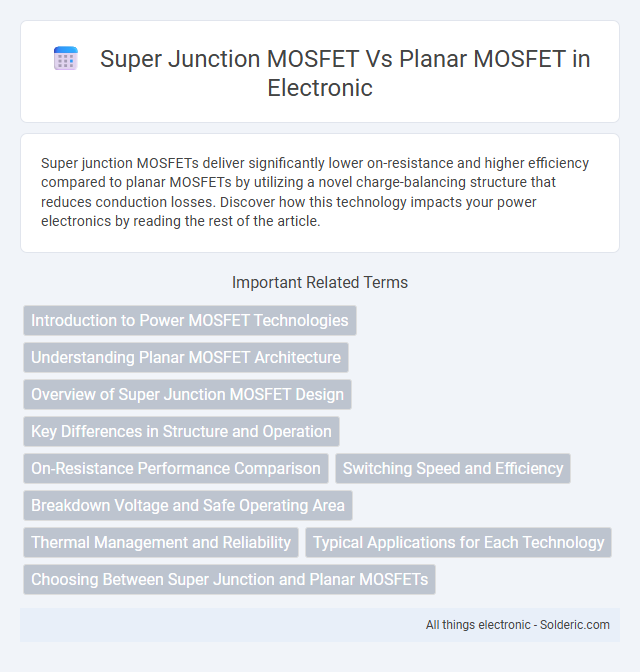Super junction MOSFETs deliver significantly lower on-resistance and higher efficiency compared to planar MOSFETs by utilizing a novel charge-balancing structure that reduces conduction losses. Discover how this technology impacts your power electronics by reading the rest of the article.
Comparison Table
| Feature | Super Junction MOSFET | Planar MOSFET |
|---|---|---|
| Structure | Multi-layered alternating p-n junctions | Single-layer planar structure |
| On-Resistance (RDS(on)) | Lower due to charge balance | Higher compared to super junction |
| Breakdown Voltage | High, optimized for high voltage | Moderate, limited by planar design |
| Switching Speed | Faster switching with reduced losses | Slower switching speed |
| Efficiency | Higher efficiency in power conversion | Lower efficiency at high voltages |
| Cost | Higher due to complex fabrication | Lower, simpler manufacturing process |
| Application | High voltage power supplies, automotive inverters | Low to medium voltage applications |
Introduction to Power MOSFET Technologies
Super junction MOSFETs utilize a multi-layered structure with alternating p-type and n-type regions that enable higher voltage blocking capability and reduced on-resistance compared to traditional planar MOSFETs. Planar MOSFETs feature a single epitaxial layer with a lateral channel layout, resulting in higher conduction losses at elevated voltages. The advanced charge balancing technique in super junction technology significantly enhances efficiency and performance in high-voltage power applications such as electric vehicles and industrial converters.
Understanding Planar MOSFET Architecture
Planar MOSFET architecture features a flat, lateral structure where the gate lies parallel to the silicon surface, enabling charge control through an oxide layer. This design offers simplicity and proven reliability but faces limitations in breakdown voltage and on-resistance due to lateral current flow and junction depth constraints. Understanding these characteristics helps you evaluate the performance trade-offs compared to Super Junction MOSFETs in high-voltage applications.
Overview of Super Junction MOSFET Design
Super Junction MOSFETs utilize alternating p-type and n-type layers within the drift region to significantly reduce on-resistance and enhance breakdown voltage compared to Planar MOSFETs. This innovative layer structure allows for superior efficiency in high-voltage power applications by minimizing losses and improving thermal performance. Your power electronic designs benefit from this advanced architecture, delivering higher performance and reliability in demanding environments.
Key Differences in Structure and Operation
Super junction MOSFETs feature alternating p-type and n-type pillars in the drift region, enabling higher breakdown voltage and lower on-resistance compared to planar MOSFETs, which have a uniform drift region. The unique multi-layered structure of super junction devices reduces electric field crowding, enhancing efficiency in high-voltage applications. Planar MOSFETs rely on a simpler lateral channel and vertical current flow, resulting in limitations in voltage handling and power loss under high-stress conditions.
On-Resistance Performance Comparison
Super junction MOSFETs exhibit significantly lower on-resistance (R_DS(on)) compared to planar MOSFETs due to their unique multi-layered structure that enhances charge balance and reduces drift region resistance. This design enables superior conduction efficiency, especially at higher voltages, making super junction MOSFETs ideal for power conversion applications requiring minimal energy loss. Optimizing your circuit with super junction technology can result in improved efficiency and thermal performance relative to traditional planar MOSFETs.
Switching Speed and Efficiency
Super junction MOSFETs deliver significantly higher switching speeds compared to planar MOSFETs due to their reduced charge storage and lower gate-drain capacitance. This technology enhances efficiency by minimizing conduction and switching losses, making it ideal for high-frequency power conversion applications. Planar MOSFETs, while simpler in design, typically exhibit slower switching and higher losses, limiting their performance in advanced power electronic systems.
Breakdown Voltage and Safe Operating Area
Super junction MOSFETs exhibit significantly higher breakdown voltage compared to planar MOSFETs due to their innovative multi-layered structure that reduces electric field crowding. This enhanced breakdown voltage enables super junction MOSFETs to handle higher voltages with improved efficiency and reduced on-resistance. Moreover, the safe operating area (SOA) of super junction MOSFETs is substantially larger, allowing for greater robustness under high voltage and current stress, making them ideal for high-power applications such as power supplies and motor drives.
Thermal Management and Reliability
Super junction MOSFETs offer superior thermal management due to their lower on-resistance and reduced power dissipation compared to planar MOSFETs, enabling more efficient heat distribution and improved device longevity. The vertical structure of super junction MOSFETs provides enhanced robustness against thermal stress, resulting in higher reliability for high-power applications. Your designs benefit from these characteristics by achieving better performance under demanding thermal conditions and extended operational life.
Typical Applications for Each Technology
Super junction MOSFETs are widely used in high-efficiency power supplies, electric vehicle inverters, and motor drives due to their superior conduction and switching performance at high voltages. Planar MOSFETs find applications in low to medium voltage circuits such as DC-DC converters, power management in portable devices, and general-purpose switching where cost and ease of integration are critical. Both technologies cater to different power and efficiency requirements, with super junction devices excelling in demanding high-voltage environments and planar MOSFETs offering reliable performance in less intensive electrical systems.
Choosing Between Super Junction and Planar MOSFETs
Super junction MOSFETs offer significantly lower on-resistance and improved efficiency at high voltages, making them ideal for power electronics in automotive and industrial applications. Planar MOSFETs remain cost-effective and reliable for lower voltage designs where switching speed and thermal performance are less critical. Evaluating the trade-offs between conduction losses and manufacturing complexity is essential for selecting the right device for high-frequency switching circuits or cost-sensitive systems.
Super junction MOSFET vs Planar MOSFET Infographic

 solderic.com
solderic.com